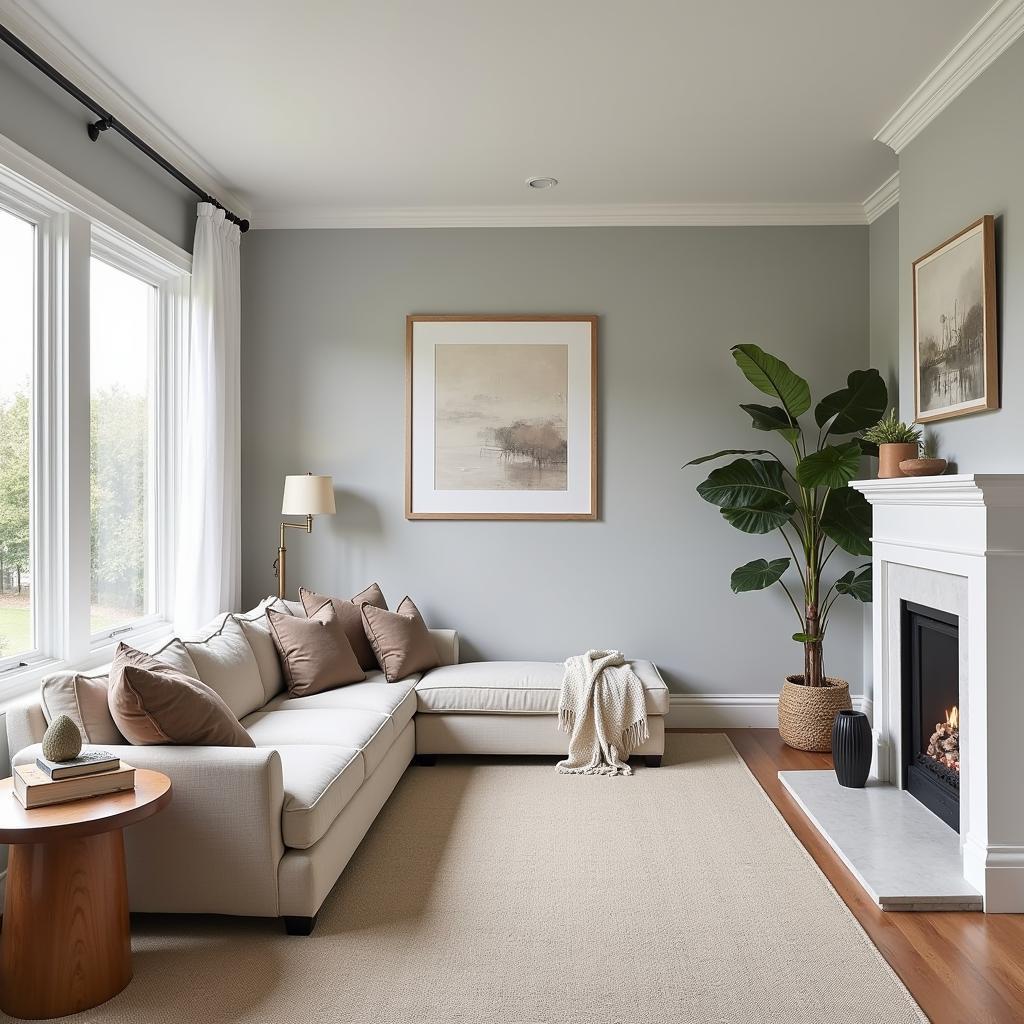Passive gray is a versatile and sophisticated neutral that’s become a popular choice for interior and exterior design. Its subtle undertones allow it to act as a perfect backdrop, making it easy to pair with a wide range of colors. Whether you’re looking for a calming, vibrant, or dramatic aesthetic, understanding What Colors Go With Passive Gray can unlock endless design possibilities for your space.
Unveiling the Versatility of Passive Gray
Passive gray sits comfortably between a true gray and a greige, often with subtle hints of green, blue, or purple. This complexity is what makes it so adaptable. It’s not as stark as pure gray, offering a warmer, more inviting feel. Choosing the right complementary colors can transform passive gray from a quiet background into a statement piece. This guide will explore various color combinations, from classic pairings to unexpected yet striking contrasts, helping you find the perfect palette for your project.
Classic & Calm: Neutral Pairings with Passive Gray
For a timeless and tranquil atmosphere, combining passive gray with other neutrals is a foolproof strategy. Think creamy whites, soft beiges, and warm taupes. These colors create a serene backdrop that’s both elegant and inviting.
- White: A crisp white trim against passive gray walls provides a clean, modern look.
- Beige: Warm beige accents, such as furniture or textiles, add a touch of comfort and sophistication.
- Taupe: This earthy neutral creates a grounding effect, perfect for creating a cozy and inviting space.
 Passive Gray Living Room with Neutral Accents
Passive Gray Living Room with Neutral Accents
Bold & Beautiful: Using Accent Colors with Passive Gray
If you prefer a more vibrant and energetic feel, consider pairing passive gray with bolder accent colors. Jewel tones, such as emerald green, sapphire blue, and ruby red, can create a dramatic and sophisticated contrast.
- Green: The coolness of passive gray complements the richness of emerald green, creating a balanced and visually appealing combination.
- Blue: Deep blues, like navy or cobalt, offer a striking contrast against the subtle gray, adding a touch of drama and elegance.
- Red: A pop of ruby red can inject energy and personality into a passive gray space, creating a focal point and adding warmth.
Soft & Subtle: Pastel Harmony with Passive Gray
For a softer and more romantic aesthetic, pastels are a perfect complement to passive gray. Think blush pink, lavender, and mint green. These delicate hues create a gentle and calming atmosphere, ideal for bedrooms and nurseries.
- Pink: Blush pink adds a touch of femininity and warmth, creating a cozy and inviting space.
- Lavender: This calming purple hue pairs beautifully with the cool undertones of passive gray, creating a serene and relaxing atmosphere.
- Mint Green: A refreshing mint green accent adds a touch of vibrancy without overpowering the neutrality of the gray.
What Trim Color Goes Best with Passive Gray Walls?
White is a classic choice for trim with passive gray walls, creating a clean and modern look. However, other options like a slightly darker gray or a warm off-white can also work well, depending on the desired aesthetic.
Can I Use Passive Gray in a Small Room?
Absolutely! Passive gray’s neutrality can actually make a small room feel larger and more open, especially when paired with lighter accents and plenty of natural light.
Is Passive Gray a Good Choice for an Exterior?
Yes, passive gray is a popular choice for exterior paint. Its versatility allows it to complement a variety of architectural styles and landscaping.
Expert Insights
“Passive gray is like a chameleon in the design world,” says renowned interior designer, Amelia Grant. “Its ability to adapt to various color palettes makes it an incredibly versatile choice for any space.”
Another expert, color consultant, David Miller, adds, “The key to successfully using passive gray is understanding its undertones and selecting complementary colors that enhance its subtle beauty.”
Conclusion
Passive gray is a truly versatile color that offers endless design possibilities. Whether you prefer a calm and neutral space or a bold and vibrant one, understanding what colors go with passive gray is essential for creating a cohesive and aesthetically pleasing design. From classic pairings to unexpected contrasts, the right color combinations can transform passive gray into a stunning backdrop for any room.
FAQ
- What undertones does passive gray have? Passive gray can have subtle green, blue, or purple undertones.
- What is the best white trim color for passive gray? A crisp, clean white is often the best choice.
- Can I use passive gray in a kitchen? Yes, passive gray can look stunning in a kitchen, especially with white or wood cabinets.
- What are some good accent colors for a passive gray living room? Blues, greens, and yellows can work well.
- Is passive gray a warm or cool color? It can be considered both, depending on its undertones.
- What sheen is best for passive gray walls? Eggshell or satin sheens are popular choices.
- What type of lighting works best with passive gray? Both natural and warm artificial light complement passive gray.
Need Help with Your Color Choices?
Contact us for a free consultation! Phone: 0373298888, Email: [email protected] or visit our showroom at 86 Cầu Giấy, Hà Nội. Our 24/7 customer service team is ready to assist you.

